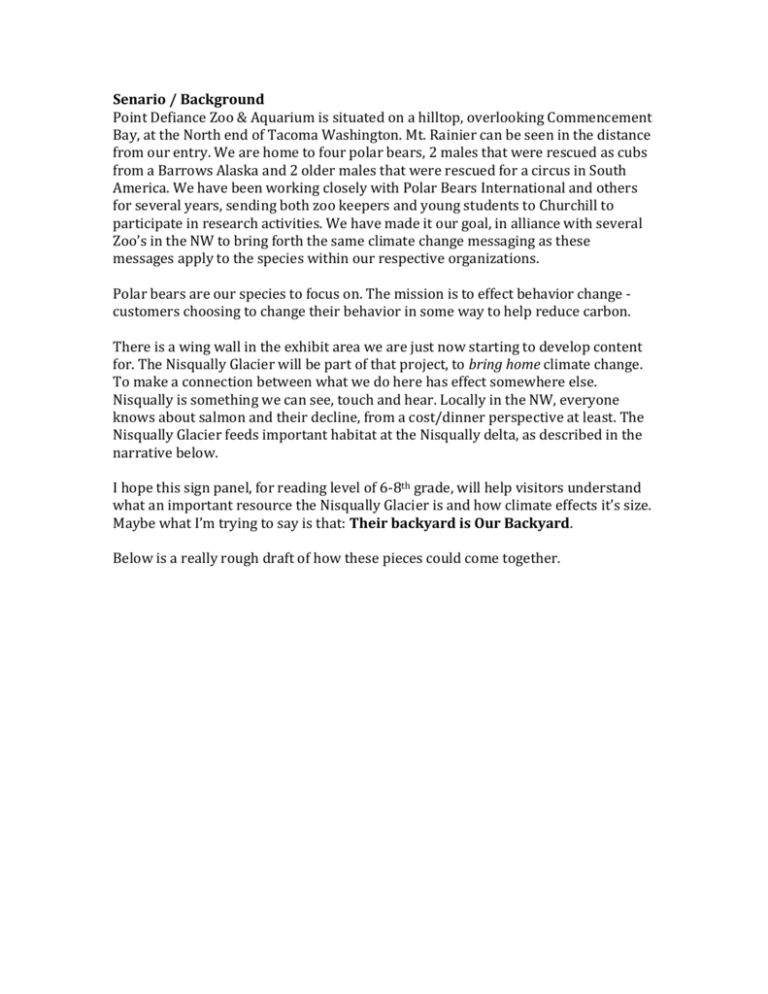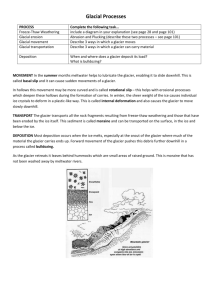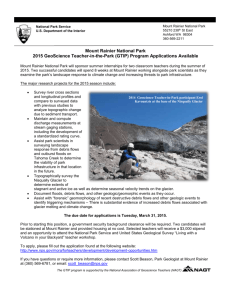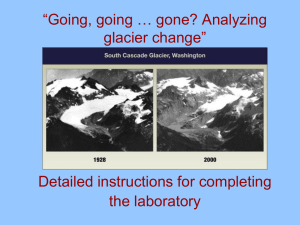Senario / Background Point Defiance Zoo & Aquarium is situated on
advertisement

Senario / Background Point Defiance Zoo & Aquarium is situated on a hilltop, overlooking Commencement Bay, at the North end of Tacoma Washington. Mt. Rainier can be seen in the distance from our entry. We are home to four polar bears, 2 males that were rescued as cubs from a Barrows Alaska and 2 older males that were rescued for a circus in South America. We have been working closely with Polar Bears International and others for several years, sending both zoo keepers and young students to Churchill to participate in research activities. We have made it our goal, in alliance with several Zoo’s in the NW to bring forth the same climate change messaging as these messages apply to the species within our respective organizations. Polar bears are our species to focus on. The mission is to effect behavior change customers choosing to change their behavior in some way to help reduce carbon. There is a wing wall in the exhibit area we are just now starting to develop content for. The Nisqually Glacier will be part of that project, to bring home climate change. To make a connection between what we do here has effect somewhere else. Nisqually is something we can see, touch and hear. Locally in the NW, everyone knows about salmon and their decline, from a cost/dinner perspective at least. The Nisqually Glacier feeds important habitat at the Nisqually delta, as described in the narrative below. I hope this sign panel, for reading level of 6-8th grade, will help visitors understand what an important resource the Nisqually Glacier is and how climate effects it’s size. Maybe what I’m trying to say is that: Their backyard is Our Backyard. Below is a really rough draft of how these pieces could come together. Nisqually Glacier, Mt. Rainier in the Pacific Northwest, 70 miles from Tacoma, Washington. Mt. Rainier can be seen from the north end of Tacoma, across the bay toward the east, in the Cascade mountain range that runs across the horizon to Canada. It is capped with snow year round. Each of its rising peaks and snow covered glaciers have been named and measured. If you know where to look, you can see some the glaciers and recognize the peaks. The Nisqually Glacier is one of them. Its melting water mixes with other streams of water to form the Nisqually River. The final home for the glacier-melt is trails into 900 acres of salt marsh between Tacoma and Olympia, in the Puget Sound. It’s waters are essential to the existing habitat. Nourishing plants and animals alike, from its solid ice origin, up on the mountain, to its liquid sate, it travels all the way to the sea, some ______ miles. It is one of the most accessible glaciers on the mountain, you can get really close and see what a glacier looks like, in person. You will feel small, standing high on the mountain slope, looking up at the mountain-top ahead of you and over the Cascade mountain range to the sides. You’ll not only see the snow and ice, you’ll feel the strength of great glacier - it’s great, thick mass of solid ice, speckled with soot. On cloudy days, you may not be able to see as far, but you will walk in the clouds. (I have a photo from a climb I did in the spring, May be good to add) Prior to 1990, the Nisqually Glacier was home to a magnificent ice cave. Beautiful photos have been taken through the ice sheet. (May have to omit the ice cave, but it is a good way to talk about the melting and the shape of healthy melt versus rapid melt.) Travelers came to the mountain just to see the caves, climbing from an elevation of 5450 at the trail-head of Paradise. The way the glacier was melting formed a nice opening at the mouth, stretching back, under the ice and branching off into smaller tunnels, water ran out of the opening. At that time, people walked right along the sides of the stream-bed. Now a very nice trail is provided to protect fragile plants that grow in the rocky surface. The shape of the Nisqually Glacier is changing, at a rapid pace. It is not an isolated case of glacier melting, most ice forms in the world experiencing change. Can you imagine Mt. Rainier without glaciers on it? How do you think it matters if a glacier melts and is gone? Could make the flip signs specific to this. The Nisqually Glacier is a frozen reservoir of water, a large, heavy, perennial mass of ice that flows. It was formed because more snow accumulated than was lost each year. New snow fall buries and compresses the snow underneath, changing it from a fluffy grouping of ice crystals into dense, hard ice. Most of the glacier snow falls on the upper part of a glacier, at higher altitudes, in the “accumulation zone”, and is covered with snow year-round. Ice in the accumulation zone flows down hill to the lower elevations (ablation zone), where more snow is lost than accumulates. In late summer, when the seasonal snow has melted away from the surrounding valley walls, bare ice of the ablation zone is exposed. Check out the diagram below. It shows some of how a glacier is made and moves. Cross section of an alpine glacier, showing snow being converted into glacier ice (the left side of the figure) and the two major zones of a glacier’s surface. The red arrows show the direction and relative speed of different parts of the glacier. The longer the arrow, the faster ice is moving. Climate determines how much snow a glacier receives and how fast it melts. Nisqually gains snow October-May and melts June-September. Has this changed like it has in the Arctic? There is a difference between “weather” and “climate”. Weather is a short-term, day-to-day condition of a particular place. It is what the atmosphere is doing over a short period of time (i.e. cloudy, rainy, or sunny; cool or warm today). This atmosphere can be observed and predictions can be made. Climate is the long-term behavior patterns of the atmosphere; the long term averages of temperatures and precipitations of the weather conditions – but climate is brought forth through a complex system of triggers and reactions between earth and the sun through a Feedback processes that can enhance (positive feedback) or weaken (negative feedback) the effect on climate change triggers. Some of which we understand, and some of which we are only beginning to understand. (Manitoba Eco-Network, Climate Change Connection). The Atmospheric Model Layers below, created by the National Science Foundation, is an example of Feedback process and some of its triggers. You’ll notice the lack of human activity in the illustration. The Nisqually Glacier receives its snow fall because of the atomopheric activities going on in the world, as seen in the model above. It melts and retains snow and ice because of the same Atmospheric conditions. More snow has to fall and less can melt to keep this glacier on the mountain. It originates at the summit of Mount Rainier at about 14,400 feet altitude and descends to about 5000 feet. It’s historic range could be added with images here. The Nisqually Glacier volume is an important because it is a frozen reservoirs of water, important to water resource planning and to the wildlife that live along the shore of the Nisqually river. The glacier-fed river has a relatively constant flow compared to streams from ice-free valleys. It provides a steady source of nice cold mountain water year round for the fish that live and spawn in the river. In the hot summer glaciers generate lots of meltwater, keeping the flow going. The ecosystems that develop along the glacier-fed streams and rivers are dependent on this steady source of cold freshwater. There are many glaciers on Mt Rainier. The Tahoma is what we see from Tacoma, Nisqually is just around the side of the mountain to the right. See map below The location of a glacier affects the amount of glacier change in response to climate. South facing glaciers on Mount Rainier, like the Nisqually, have retreated faster than north facing glaciers over the past 80 years. Need to explain why. The glaciers on the south side are generally smaller and lower in elevation (on average) than the north side glaciers, making them more susceptible to changes in the freezing level. One way to measures ice thickness is to use a portable ice-penetrating radar transmitter/receiver that can be towed or carried across the glacier’s surface. As the unit travels over the surface, it sends a radar pulse through the snow and ice until it hits the base of a glacier. The pulse bounces back, sending data to the receiver. Using this tool is one way we can figure how much water is in the glacier. Operation of Ice Penetrating Radar Need to do more with events – no changes at this time. H>L>H>A>L> Snow fall (H) on the mountain (L) is from water evaporation (H) from the west. It is carried through the atmosphere (A) over the land (L) until it is deposited on the mountain. Changes to the quantity of precipitation (L) would have an impact on the plants and animals (B) in the area, as well as down stream. H>H>H>L>B The amount of snowfall (H) must be greater that the amount of melt off (H) for a glacier to maintain its size and supply water to the habitats below. Reduced or increased water supplies in the streams and rivers (H) will effect both the terrain (L) and composition of plants and wildlife (B). H>L>H>B>B>B>B>L>H>L> Melting ice (H) from the glacier run downstream to the (L) salt marsh in Puget Sound (H), creating essential fish habitat (B) for fish. The fish (B) are food for larger fish (B), which created food for humans (B) and the fishing industry. The salt marsh (L) area filters water (H), returning clean water to the water table in the earth (L) below and sends fresh water to the sea (L). Resources 1. Mt. Rainier National Park, Nisqually Glacier; by Frank D. Granshaw (Geology Department at Portland State University) and Dr. Andrew G. Fountain (PSU Departments of Geology and Geography). Assistance was provided by Thomas Nylen (PSU Department of Geology), Barbara Samora and Darin Swinney (Mt. Rainier National Park), and Carolyn Driedger (Cascade Volcanic Observatory) 2. http://www.nps.gov/archive/mora/ncrd/glacier/Basics00.html 3. Recent glacier and climate variations in the Pacific Northwest, Stephen C. Porter, Quaternary Research Center, University of Washington 4. Burbank, D. W. (1982). Correlations of climate, mass balances, and glacial fluctuations at Mount Rainier, Washington, U. S. A., since 1850. Arctic and Alpine Research 5. USGS Science for a changing World; USGS/Cascades Volcano Observatory, Vancouver, Washington 6. add resources from the senator climate senario. Problem Statement – The shape of the Nisqually Glacier is changing, at a rapid pace. If a glacier melts and is gone, does it matter?








